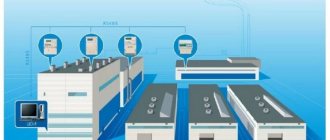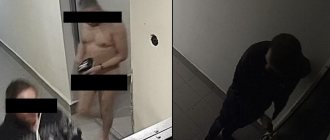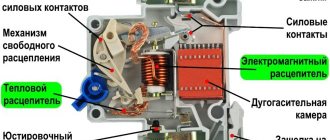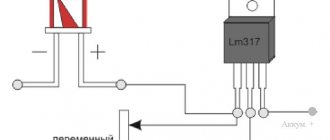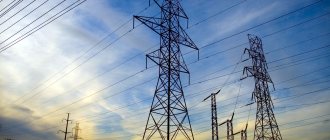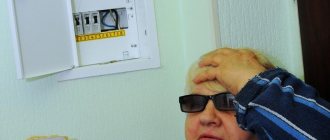Expert author of the article
Olga Ivanovna Avtushko
Leading civil engineer in a construction and installation organization. Work experience - 19 years.
Electricity distribution companies are forcing owners of private houses to install metering panels on the street. The electronic meter on the pole is a cause of disagreement and controversy. Each side pursues its own interests. It is important for suppliers that their energy is not stolen. Consumers are concerned about payments. Advanced technologies, compliance with laws and installation requirements solve the problem.
Why install meters on poles?
For Energosbyt, connecting to the street is beneficial:
- the presence of residents during inspection, control measurements and replacement of faulty equipment is not required;
- there is less chance of electric shock, since the equipment is located in closed panels;
- Pole-mounted electricity meters prevent electricity theft.
The new regulations add further inconvenience to private sector owners.
- When placed outdoors, breakdowns are more likely to occur. Temperature changes, condensation, and solar radiation damage capricious electronics. Wear accelerates. Measurements are distorted.
- Sometimes the installation of an electricity meter on a pole is carried out incorrectly. The standards prohibit the height from exceeding 1.7 m. If the mark is higher, it is difficult to take readings.
- The decision to remove devices is made at a general meeting of the gardening association. The opinion of the individual owner of a country house is not taken into account.
- The electric meter belongs to the owner. Property protection is a citizen's duty. Expensive equipment on a public road is defenseless against intruders.
- In small towns and villages, equipment replacement regularly occurs without the consent of residents. People return from work - “gifts” are displayed on the supports.
Is this legal
The legislation does not prohibit the placement of meters on the street. The procedure is regulated by Government Decree No. 442 of the Russian Federation. The devices are installed at the border between the balance sheet of the supplier's network and the consumer's electrical equipment. If it is technically impossible, the points closest to the line are used.
The property line separates the zones of ownership. During new construction, it is considered legal to secure equipment on metal racks and reinforced concrete supports. For secondary connection it is allowed to use the external wall of the building.
Companies are acting illegally when they force owners to move measuring equipment outside. PUEs do not require the mandatory removal of meters. The instructions in clause 1.5.6 are advisory in nature. The same standards state that dry, accessible places are required for installation. At sub-zero temperatures, devices will need heated shields. A common violation is fastening to the top of a support. The owner has the right not to sign the contract and refuse the procedure if the rules are not followed. It is important that access is kept open.
Regulations regarding the relocation of structures are controversial. In judicial practice, decisions are made both in favor of consumers and in favor of producers. The Federal Antimonopoly Service often supports Energosbyt. The clarifications of the OFAS emphasize that the location of installation of accounting cabinets is the border of the balance sheet.
From July 2022, an intelligent electricity metering program, MIS, will be launched in Russia. “Smart” meters independently measure flow and transmit them remotely to the control server. Subscribers are given a remote control with a screen on which readings are recorded. Now there is no need to force anyone.
Follow the link for more details about the new rules for installing an electricity meter in a private home.
Select a counter
All meters that can be installed to account for energy consumption are classified according to three criteria:
- Device design;
- How to connect it;
- Type of measured quantities.
Currently, two types of devices are installed in apartments, private houses and SNT: electronic, which records and controls consumption at differentiated rates, and induction, which makes measurements by rotating the disk.
Expert opinion Evgeniy Popov Electrician, repairman
The second option is not very reliable, so it is gradually being replaced by electronic ones.
Electronic devices are best suited for outdoor installation, as they are convenient and accurate and do not react to temperature changes. However, operating conditions with a temperature of 40 degrees below zero are the ceiling for them, and in regions where such weather occurs, it is still better to install meters indoors.
How to buy an electronic meter
The most important element for the meter is the seal. After leaving the assembly line and passing quality control, two of them are installed: the first is installed by the quality control inspector, and the second by the state representative authorized to carry out verification. Places for installing seals
The date of verification is put on the seal and entered into the product passport, so the first thing you need to do when purchasing is to check them.
Expert opinion Evgeniy Popov Electrician, repairman
If it suddenly turns out that there is no verification seal, or there is a date on it that does not correspond to the one in the passport, I do not recommend buying the device. Then you won’t be able to prove anything to anyone.
The date of verification is also important. At the time of purchase of a two-phase meter, it should not exceed two years, and for a three-phase meter this period is completely reduced to one year. You can find all the necessary data in the passport
Types of meters that can work on the street and the principle of operation
The requirements for outdoor devices are higher than for home ones. External grades are mounted on the supports. When choosing, it is important to consider weather conditions. According to GOST R 53320-2005, electronics must work properly with temperature fluctuations from -25°C to 55°C. Extreme values are -40°С and 70°С. Relative humidity – 95%. Degree of protection – IP54. The characteristics are indicated in the technical data sheet.
The design consists of a housing with a terminal box, transformers or sensors, electronic microcircuits, conversion and transmission units.
Information about current and voltage is sent to the board. The values are transformed into digital codes. Pulse signals are generated at the output with a frequency proportional to the power consumption. Signals are output to the counting mechanism, control LED, transmission device, converter. The result is displayed on the screen.
The following models are installed externally:
- single-phase, three-phase;
- single-tariff, multi-tariff;
- with remote display;
- with sensors or transformers;
- with modem;
- with connection to ASKUE;
- direct, indirect connection.
Scientists have developed a modernized version of pole meters - with a control panel. The calculated measurements are displayed on the display of the remote device.
New counters solve intellectual problems:
- transmission of measurements;
- power limitation;
- event logging;
- setting up a schedule by day of the week;
- tariffication;
- AC sine wave recording;
- disconnecting the load according to specified parameters;
- consumption reading with archiving;
- dispatcher control;
- regulation of display modes.
Each product is assigned an ID number. The indicators are transmitted to the collection center via a cellular communication channel. To work you need WI-FI, SIM card, mobile application. The invoice for payment is automatically sent to your personal account. With regular debt, energy supply is limited.
Types of devices with remote control:
- with or without software;
- with partial or complete shutdown;
- with infrared control or radio control.
By 2023, it is planned to completely replace old equipment with remote-controlled electricity meters.
There is another type of electricity meters with remote control. Their sale and use is illegal.
Common methods of stealing electricity
"Bug" or theft of electricity from wires
This method is applicable in the private sector. We recommend that you periodically inspect the overhead cable line running through your street. It may turn out that they are stealing from you! This is relevant in dacha cooperatives, since the general cooperative needs for electricity supply will fall on your shoulders.
An unauthorized connection of the entire home network to an electrical input or overhead power line occurs, thereby bypassing the energy meter. Sometimes scammers use this method to power individual particularly powerful consumers. As a rule, supply wires are thrown onto an unprotected power line, the other ends of which are already integrated into the intra-house network after the meter. In this case, the input machine is turned off, excluding the flow of current through the meter itself. Or they simply power a powerful, voracious consumer, such as an electric heater, welding machine, or other devices, using this method.
If you are sure that your neighbor has energy-intensive equipment, then it is worth taking a closer look.
"Left zero." Operation of the meter without a neutral wire
Once again, when passing by the energy meter, pay attention to whether it is counting. If the readings do not change for a long time, but you are sure that electricity is being used, we recommend contacting the relevant authorities.
This method is very common among scammers in the post-Soviet space due to its simplicity. The essence of the theft process is the notorious bypass of the meter along the neutral wire. We recommend taking a closer look at old disk counters. Old-style metering devices are susceptible to the flow of currents through the neutral wire, and in the absence of such, the device simply stops taking into account electricity consumption. As a rule, “zero” is removed from the outlet network and grounded. Borrowers can be water supply and heating pipes, metal supporting structures of the building.
A sign of such theft is the tingling sensation of electric current from heating and water supply pipes. This means that one of your neighbors is doing this.
Interference with the operation of the meter.
If the design of a metering device allows an attacker to influence its internal mechanisms, then perhaps he will not interfere with the operation of the metering device. For example, old-style meters are tilted forward at a certain angle, and they no longer adequately count energy. Also, with such counters, with certain skills, scammers manage to get through the front glass to the counting mechanism and stop it.
Magnets for the meter body
Heavy-duty magnets deserve a special place on the list (according to their advertising). We are more familiar with such products as neodymium magnets. It is understood that such products are applied to the body of the metering device, which entails failures and disruptions in the operation of the latter. The metal parts of the counting mechanism are inhibited, and the integrity of the magnetic field of the current counting coils is disrupted. At least that's what the advertisement for these magnets says. I am inclined to believe that the manufacturers of metering devices have provided for the influence of such magnets. Since counting mechanisms have long been made of non-magnetic materials.
Operation Impulse.
Craftsmen also did not sit still and finally invented a device capable of consuming electricity without “winding up” kilowatt-hours on the meter. The principle of such a device is the originality of energy consumption. This device takes it in short-term pulses, which in turn does not allow metering devices of older models to read current. This occurs due to the mechanical inertia of the counting mechanism parts.
Reprogramming the counter.
If the level of professional training of a lover of free energy is high, then he can carry out the procedure of reflashing the program algorithms of a modern meter in order to steal a certain part of the electricity.
Why the readings may not match the readings of the home meter
When the metering is taken outside, the home appliance often remains in place. Information from both devices is compared. The owners complain that the electricity meter on the pole is “lying.” The error reaches 10%.
The reason for the discrepancies is a violation of installation standards. Clause 5.1.27 of the Rules requires that devices be operated in dry rooms at a temperature not lower than 0°C. External shields are not sealed. Frost, heat, rain accelerate wear.
Line overload, breaks, short circuits lead to structural damage. Lightning, floods, and accidents on power lines destroy the network.
To appeal bills, you will need to file a statement and call a representative of the energy company. The malfunction is documented.
There is another option - the home electricity meter is lying, not the street one.
Features of application
When considering the features of remote meters, it is noted that the energy company is provided with information that is not available with conventional metering devices. Their use is characterized by expanded functionality, allowing the following capabilities to be implemented:
- presentation of information in a multi-tariff format;
- remote control of individual consumers (with the ability to switch them);
- communication with the client by exchanging notifications.
Added to this is the ability to analyze the information provided, which makes it possible to increase the efficiency of the control equipment.
Basic installation rules
The accuracy and safety of measurements is affected by proper installation.
- Before starting work, the power line is de-energized.
- The equipment is mounted on a rigid support. The terminals are fixed at a height of 0.8-1.7 m. The branch to the consumer is laid at a level of no lower than 3.5 m above areas where people walk, and no lower than 6 m above the roadway.
- The design of the shield is selected taking into account climatic conditions. Degree of protection – not lower than IP
- Cable descents and ascents are pulled into pipes.
- Metal elements are connected to the ground loop.
- An input circuit breaker is installed to protect against overload.
- After installation, the measuring unit is connected to the network. The diagram is attached.
- At the end of the process, a control run is performed.
- To install electricity meters, an electrical safety clearance group is required.
- The measuring block is sealed. The shield is locked.
How to connect electricity bypassing the meter. We connect a three-phase electric meter
There are two types of connection of a three-phase meter, direct and indirect, through isolating current transformers.
If it is necessary to take into account the consumption of a relatively small number of three-phase low-power consumers, then the electricity meter is installed directly into the gap in the supply wires.
If it is necessary to control sufficiently powerful consumers of a three-phase electrical network, and their currents exceed the rated value of the electric meter, then it is necessary to install additional current transformers.
For a private country house, or small production, it will be enough to install only one meter, designed for a maximum current of up to 50 amperes. Its connection is similar to that described above for a single-phase meter, but the difference is that when connecting a three-phase meter, a three-phase power supply is used. Accordingly, the number of wires and terminals on the meter will be greater.
Connecting a three-phase meter
Consider direct connection of the meter
The supply wires are stripped of insulation and connected to a three-phase circuit breaker. After the machine, three phase wires are connected to the 2, 4, 6 terminals of the electric meter, respectively. The output of phase wires is carried out to 1; 3; 5 terminals. Input Neutral wire is connected to terminal 7. Output to terminal 8.
After the meter, for protection, automatic switches are installed. For three-phase consumers, three-pole circuit breakers are installed.
More conventional, single-phase electrical appliances can also be connected to such a meter. To do this, you need to connect a single-pole circuit breaker from any outgoing phase of the meter, and take the second wire from the neutral grounding bus.
If you plan to install several groups of single-phase consumers, they must be evenly distributed by powering the circuit breakers from different phases after the meter.
Connection diagram for a three-phase electric meter
Indirect connection of the meter through current transformers
If the consumed load of all electrical appliances exceeds the rated current value that can pass through the meter, it is necessary to additionally install current isolating transformers.
Such transformers are installed in the gap of power current-carrying wires.
The current transformer has two windings, the primary winding is made in the form of a powerful bus threaded through the middle of the transformer; it is connected to the break in the power wires supplying electrical consumers. The secondary winding has a large number of turns of thin wire; this winding is connected to the electric meter.
Meter connected via current transformers
This connection is significantly different from the previous one; it is much more complex and requires special skills. We recommend inviting a qualified specialist to work on connecting a three-phase meter with current transformers. But if you are confident in your abilities and have similar experience, then this is a solvable task.
It is necessary to connect three current transformers, each for its own phase. Current transformers are mounted on the rear wall of the input cabinet. Their primary windings are connected after the input switch and a group of protective fuses, into the break of the phase power wires. A three-phase electric meter is installed in the same cabinet.
The connection is made according to the approved diagram.
Current transformer connection diagram
A wire with a cross section of 1.5 mm² is connected to the power wire of phase A, before the installed current transformer, its second end is connected to the 2nd terminal of the meter. Similarly, connect wires with a cross-section of 1.5 mm² to the remaining phases B and C; on the meter they go to terminals 5 and 8, respectively.
Is it possible to bypass
The theft of electricity causes damage to both the citizen and the state. Lovers of “freebies” hack into panels, install gadgets to stop the count, and are included in the circuit without permission. Attempts to cheat the meter lead to fires, power surges, and damage to household appliances.
The government has introduced amendments to the Code of Administrative Offenses of the Russian Federation. From 2022, a triple fine will be issued for repeated illegal tappings. For the first violation you will have to pay 10-15 thousand rubles. For a repeat – from 15 to 30 thousand rubles. A relapse is fraught with removal from office for 2-3 years. For legal entities the measures are stricter. Failure to pay fines may result in exclusion, a ban on traveling abroad, seizure of property, or court action.
The authorities hope that innovations will stop the mass outrages in the electricity sector.
Thanks to smart mechanisms, conscientious subscribers will not have to pay the bills of offenders. Responsibility will fall on the debtors. New models will help resolve disputes between suppliers and consumers. Useful article? Rate and share with friends!
Terms of delivery of electrical equipment:
- The minimum order amount is 15,000 rubles including VAT.
- We work only with legal companies, payment is made to a bank account.
- We ship products by transport company SDEK, Business Lines, PEK, etc. Free delivery to the TK terminal with which you work is possible.
Consult with an engineer regarding the sale of electrical equipment. A specialist will select a solution depending on the required functionality of the equipment.
Basic prices are posted on the website. To receive YOUR prices, send applications! Phone Email

